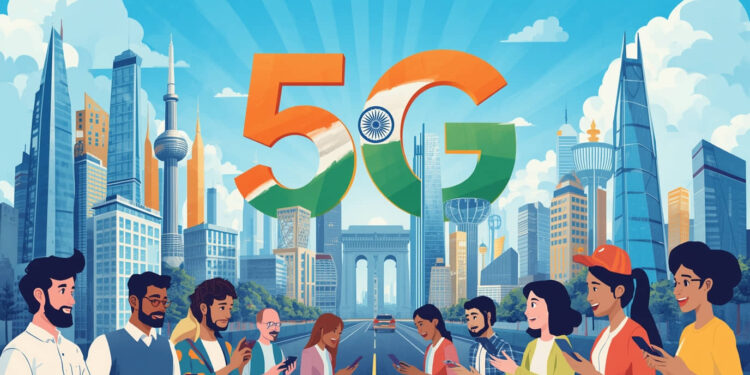India becomes the fastest 5G nation in the world with 4.7 lakh (470,000) 5G Base Transceiver Stations (BTS) installed in India in two years flattening out its digital landscape to globally benchmarked standards of multi-gigabit per second network speed.
Unprecedented Speed and Scale
Deployed in October 2022; an historic jump for India, with 470,000 BTS in all states and union territories up to the middle of 2025. The cycle is unparalleled in the world, already with 5G available in 99.8% of counties. India succeeded in rolling out 5G to about 80% of the population, connecting its towns and cities and delivering high-speed internet to many of those who live beyond them.
Driving Forces Behind the Rollout
The industry led the rollout: it was presided over by its key telco players —Reliance Jio, Bharti, and Vodafone Idea (Vi) — underpinned with serious government groundwork and policy reforms. The focus on accelerating the pace of technology was possible due to Make in India — a policy that enabled Indian domestic manufacturing of 4G and 5G equipment, reducing expenditure on network deployment; resulting in the lowest rates for 5G data applications – fastest speed at virtually insignificant cost.
Growth in 5G Subscribers
In mid-2025, India had 365 million 5G subscribers, or about 35% adoption amongst mobile users. The rapid adoption was being fuelled by:
- Affordable 5G-enabled smartphones.
- Competitive tariffs with little premium to be paid over 4G.
- Quick telecom infrastructure upgrades, particularly in the hinterland.
Socio-Economic Impact
The widespread deployment and adoption of 5G is expected to have a multi-faceted impact on Indian society and economy:
- Healthcare: With low latency connectivity, telemedicine and remote diagnostics and mobile clinics can transfer data in real-time – transforming healthcare in rural and isolated areas.
- Education: eMBB enables video streaming, virtual classes and electronic content distribution for millions of students.
- Industry: 5Genables modern manufacturing, logistics and farming — from smart factories and industrial automation to IoT-driven precision agriculture.
- City planning: High-speed 5G technology is used for traffic management, optimized energy usage, public safety and governance in smart cities.
- Enterprise: Fixed Wireless Access (FWA) gives another option to fiber, enabling business customers to obtain high-speed internet connectivity in locations without fixed infrastructure.
Operator Innovations
- Reliance Jio launched JioAirFiber and surpassed all to lead the 5G FWA market with 7.4 million users. Jio’s network slicing capabilities now support various use cases for enterprise-grade services.
- Bharti Airtel sped up the roll-out of 5G and joined hands to build private 5G networks, like that which resulted in India’s first mobile/5G-assisted car manufacturing facility.
- Vodafone Idea has launched 5G in 18 large cities and is narrowing the focus to AI-driven network management and industrial automation.
- BSNL began 5G trials and is implementing the first private 5G network in the refinery space.
Emerging Use Cases and Technologies
In addition to faster broadband rates, the ecosystem is investigating:
- Industrial and Agricultural Precision IoT for Maintenance.
- Intelligent city platforms with IoT for urban services.
- Driverless cars with data transfer in real-time.
- AR/VR Based Advanced Education and Training Use Cases.
Security and Challenges
The introduction of 5G networks also brings new security challenges requiring adequate zero trust architecture and end to end security in the network. Indian policy makers have advised to use secure supply chains, network monitoring using AI and protocols on cloud.
Private 5G networks — one of the more hyped business use cases — have only been very slowly adopted as organizations have questioned both costs and whether existing 4G/Wi-Fi options were enough for most corporate uses. But, pilots in other industrial applications spell future potential.
India’s Path to 6G
Riding the wave of a next-gen revolution, India paving way for global 6G supremacy. There are more than 100 R&D projects underway, and the government’s “6G Vision Document” lays out a road map to making the valley into a technology powerhouse by 2030.
Comparative Global Landscape
India’s quick success is in contrast to developed economies, many of which needed longer to achieve the same levels of 5G penetration and infrastructure. Heavy usage, combined with low costs have made India an exemplary digital model for other developing nations.
Conclusion
India’s 4G BTS deployments of 47 lakh in less than three years is world record and it paves the way for digital inclusion and economic development. For India, aided by significant push from the government, innovation drive from industry and huge social dividends, it is not just leading the wave of 5G but is also getting set to define its course for 6G and beyond.


